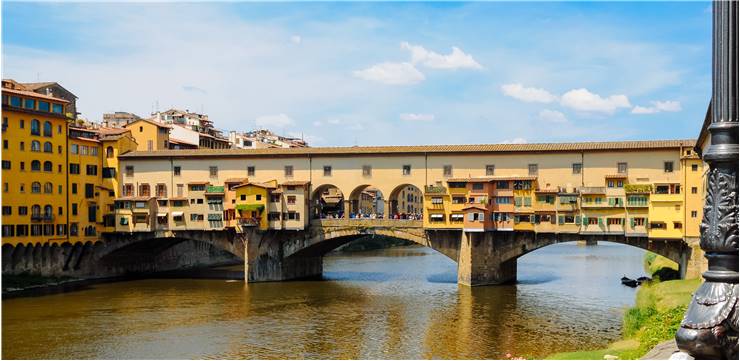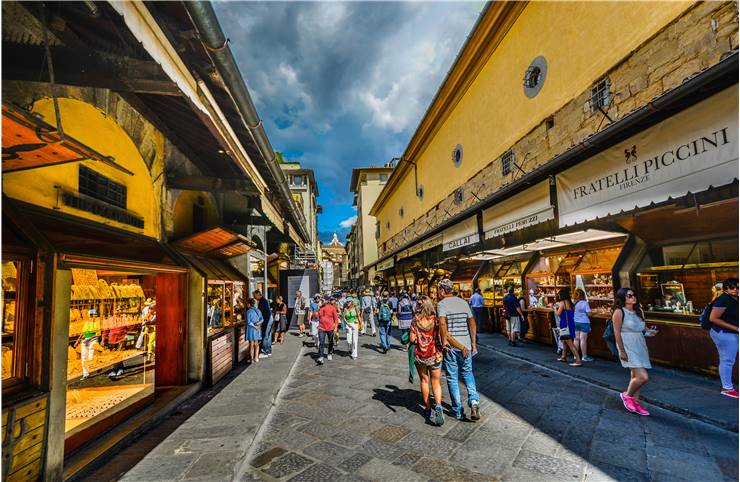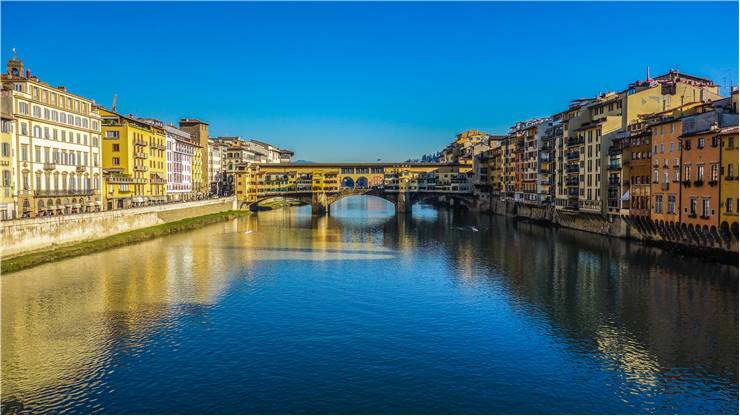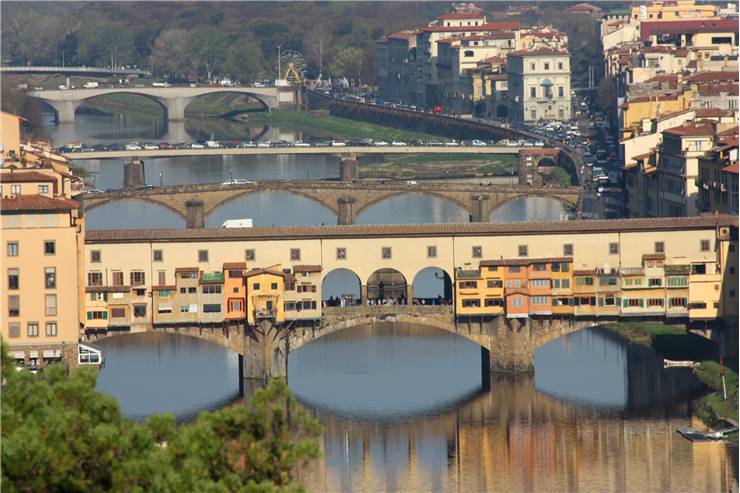Ponte Vecchio - History of Oldest Bridge in Florence and Vasari Corridor
The Ponte Vecchio (meaning “the old bridge” in Italian) is one of the most famous bridges in Italy. Spanning the Arno River in the center of the city of Florence, this medieval stone closed-spandrel segmental arch bridge has managed to become one of the city’s most illustrious landmarks. The most important characteristics of this ancient bridge are that it at first look it does not even resemble a traditional bridge. Instead, Ponte Vecchio has managed to retain the original form that many Italian bridges held in the past – with shops that are layered one atop another just on the side on the main passageway of the bridge. Originally this bridge housed butchers and fish sellers, but some centuries ago it was transformed into a popular tourist attraction, and shops are now focused on selling jewelry, art, and souvenirs.
Ponte Vecchio is the oldest bridge in Florence and was the only bridge across the Arno River until 1218. During its long history, it was augmented and rebuilt several times (most notably after the flood of 1345 destroyed it almost completely), and it miraculously managed to survive World War 2 retreat of the German army from the city, remaining as the only untouched bridge in entire Florence. Many believe that this bridge was not destroyed because of explicit orders that Hitler gave to the retreating army.
Today, Ponte Vecchio bridge remains open for pedestrian traffic, making it one of the most popular tourist attractions in the city. The Vasari’s Corridor above the bridge is a cultural heritage site, and only parts of it are opened to the public.
Even though Ponte Vecchio was rebuilt several times due to flooding damage, it managed to survive World War 2 as the only standing bridge in the city
History of Ponte Vecchio
The history of the Ponte Vecchio spans so much into the past that we today don’t even know when its original version was first built. What we do know is that ancient Roman architects and builders elected to create a bridge over the Arno River at its narrowest point in the city of Florence, using three stone arches that span over the entire river. The earliest written records of the original bridge can be traced all the way to theyear 996. Over the next four centuries, the bridge would be destroyed two times after enormous floods swept it almost completely away – first in 1117 and then again in 1333 when only two of its central piers survived. 12 years later in 1345, the rebuilding of the bridge was finalized, and this time it was in the form that would survive for a very long time. The process of the rebuilding was described by the art-historical writer, painter and architect Giorgio Vasari, who noted that the bridge was designed by Taddeo Gaddi (famous for painting and designing several basilicas across Florence).
The original design of the bridge included the center opening of the bridge with a small little loggia that housed small dedication stone and four towers that were intended to use as a military defense points in the event of the city siege. Today, only one of those defense towers (Torre dei Mannelli) has survived at the southeast corner of the Ponte Vecchio bridge. The tower caused issues during the construction of the famous Vasari Corridor – a special elevated passageway on top of Ponte Vecchio bridge that members of the ruling Medici family used to travel in style between their palace and the city’s central government offices (and their other residences). Because owners of the tower refused to tear it down, Vasari Corridor had to be wrapped around the tower. The tower was one of the few parts of the bridge structure that were damaged in World War 2, but it was restored immediately after the war. Today, anyone visiting Ponte Vecchio can visit Torre dei Mannelli, and it's ice cream shop that is located on the ground floor of the tower.
Multi-level nature of the bridge was of course not always present. The bridge had a single level of foot traffic until the 2nd half of 16th century when wealthy and influential Florentine family of Medici moved from Palazzo Vecchio to Palazzo Pitti. They decided then they needed quicker and safer travel route between their Palazzo Pitti and Uffizi (location where city magistrate operated), enabling them to easily reach the core of city’s power. To achieve this, they contracted architect Giorgio Vasari to build elevated passage atop the Ponte Vecchio base level. The result of that work was Corridoio Vasariano, which was finished in 1565.
Original Bridge
Very little is known about the original bridge that spanned the Arno River in Florence well before the construction of the modern bridge that is still standing tall today. The Romans were very accomplished bridge builders, utilizing new technologies such as mixing of strong concrete to easily create large and resilient stone structures. The exact timing of when they have built a bridge over Arno River is not known since its earliest mention was found in a document dated to 996 AD. Built in three arches over the narrowest part of Arno River, the bridge immediately became home to a large number of market sellers. This tradition was long established in medieval Italy, enabling merchants to take direct advantage from a natural travel choke point. People had to cross the bridge, and therefore, had to come in close contact with merchants and their wares.
Recent History
The flood of 1966 had a great impact on the entire city of Florence. Damage was extensive across a large portion of the city, and especially on objects that were located near the Arno River. Ponte Vecchio managed to endure this flood admirably, serving as a defiant showcase of resistance against the forces of nature, and a symbol of the great city of Florence.
The bridge area also experienced a great disaster in 2016 when the large part of the Arno river embankment just to the side of the bridge collapsed down into the ground, plunging many parked cars into a crater. This event (caused by the leaking water pipe that quickly formed a large depression that caved into itself) sparked large evacuation of the nearby buildings and formation of the large repair plan that should visually impact the look of the Florence and the sights from the Ponte Vecchio bridge for years to come.
Today, tourists can experience the wonders of Ponte Vecchio bridge during the entire year. The shops built on the bridge are still open to business, and bridge can even be experienced via boat rides and on-the river presentations or even theatre/concert events.
Construction
Construction effort that transformed the old and collapsed Roman bridge into a modern version of Ponte Vecchio began in 1333 when the bridge was almost completely destroyed in a large flood that left only two of its central pillars standing. The last surviving monument of Roman construction, a large statue of the god Mars, was destroyed during that flood. Created under the oversight of the Taddeo Gaddi, the new bridge over the River Arno continued to use three stone arch design, but have adopted larger pavement area and stronger construction that aimed to better protect the bridge from future floods.
The central arch of the bridge is the largest one, spanning the distance of 30 meters (98 feet), while the two side arches that touch the embankments are a bit shorter at 27 meters (89 feet). Side arches have the rise of 3.5 meters, while central arch goes 4.4 meters up. This is enough space to allow safe passage to smaller ships and barges that want to travel under the bridge. The span to rise ratio of the arches is exactly 5:1.
Bridge construction was finished in 1345, immediately becoming famous as one of the most advanced and beautiful bridges created in medieval Italy. Its beauty served as a direct inspiration in the creation of many other bridges across Italy , including famous Rialto Bridge in Venice. Upon completion, Ponte Vecchio bridge featured two commemorations - weathered dedication stone in the middle of the bridge, and a plaque with reference to Dante Alighieri’s The Divine Comedy. Both are still preserved to this day. The third famous commemoration was added in 1900 in the form of a beautiful bronze bust of Benvenuto Cellini’s, Florence’s high regarded goldsmith from the 15 th century.
Bridge Shops
The earliest reports of shops appearing on the Ponte Vecchio can be traced all the way back to the 13th century. Even at that time, shop owners were forbidden to place their stalls and tables directly on the walkways of the bridge but were instead forced to start building their offices off the side of the bridge, supported by the wooden beams.
Initially, all kinds of ships were hosted on the sides of Ponte Vecchio, such as food sellers, butchers, and fishmongers. Merchants who wanted to sell their products on the bridge were obliged to get permission and authorization from the “Bargello” , a representative of the government that also served a role of police authority. In the beginning, the shops were owned by the city (43 of them were in operation immediately after the bridge was renovated in 1345), but later shops moved to private ownership. More and more of them were created over centuries, all “floating in the air” beside the central bridge structure, suspended by the slender wooden stakes or being built atop older shops.
After tanners started operating few shops in the early 16th century, local population and eventually government started being worried about their “waste products” that impacted the environment and caused strong smells to spread to the surrounding city. In a bid to make the bridge and the city more presentable to both visitors and city dwellers, Grand Duke Ferdinand I decreed in 1593 that only jewelers, goldsmiths, and silversmiths would be allowed to operate stores on Ponte Vecchio. This transformed the bridge completely, making it one of the unique places in all of Italy, famous all around the world, and enabled Florence to continue to be regarded as the artistic and development center of the Renaissance Italy.
The number of shops was also increased after Medici family elected to create elevated pathway above the ground floor of the Ponte Vecchio bridge. This elevated the walls of the bridge, enabling shops and new rooms to more easily be built one atop another.
Throughout the history, the thriving community of shops atop the Ponte Vecchio bridge has given birth to the economic concept of bankruptcy. This interesting development happened from the repeated events when money changers or merchants who operated on the bridge were unable to pay their debts, which led to the destruction of their selling tables by soldiers, and inability to hold shop on the bridge. Essentially, their wares (“banco”) were broken (“rotto”), which led to the coining of the term “ bancrotto”. As time went on, and the Italian Renaissance expanded their influence over Europe, the term for financial “bankruptcy” was accepted across the world.
Ponte Vecchio bridge was once home of many shops, but over the last five centuries, in it are showcased only the works of goldsmiths and artisans
Vasari Corridor
During the Italian Renaissance, famous Medici family from Florence was regarded as one of the most influential and powerful families in entire Europe. Many say that their wealth, influence and patronage of arts, development, research had enabled Europe to transition from the “Middle Ages” to the transformative Renaissance. They ruled and influenced the government of Florence and Italy for several centuries, and during that time they were responsible for the building of the several city’s large buildings, palaces, churches, and bridges. However, one of their construction efforts remains remembered today in the bright spotlight because it had such a strong impact on the looks of the famous Ponte Vecchio bridge located in the center of the city and across the Arno River.
One of the Medici rulers wanted to create a more “civilized” walkway between their residential palace at Palazzo Pitti and the center of the city at Palazzo Vecchio (today is known as the town hall of the city of Florence). Instead of building a road and a new bridge, second Duke of Florence Cosimo I de’ Medici (and later on first Grand Duke of Tuscany) commissioned the building of the elevated and passageway that would be located directly above the famous Ponte Vecchio bridge. The work was done over the period of just five months in 1565 under the oversight and direct control of architect Giorgio Vasari, after which this passage gained its name.
The passageway starts on the south side of the Palazzo Vecchio, travels alongside famous Uffizi gallery (now a prominent art museum located in the center of the preserved historic Florence) and leaves it at its south side, crosses the Lungarno dei Archibusieri, follows the bank of the river Aron, continues over the Palazzo Vecchio bridge and its numerous shops, snakes beside the walls of the Church of Santa Felicita, enters the Oltrarno district where passageway is carried by several individual houses, until it finally reaches old Medici residence at Palazzo Pitti.
Officially, Cosimo I de’ Medici commissioned this corridor as a celebration of the wedding of his son Francesco with Johanna of Austria, but in reality, he wanted a safe way to travel between his palace and government center of the city. As a monarch and government official, he felt insecure when he walked in public, especially after he took control of the city after the fall of the Republic of Florence in 1434. The family held control of the city until 1494, and again after 1512.
The corridor features extravagant decorations and presence of panoramic windows that allowed its users to observe the beauty of the city of Florence (especially the viewports across Arno River and toward Ponte Santa Trinita). Original openings were replaced by larger gallery windows during the reign of Benito Mussolini. The passageway also features balconies with railings, including one that offers private access to the church of Santa Felicita. This enabled Medici family to visit church without the need to travel down to the ground level and mix with the regular people.
Majority of the Vasari’s Corridor is today not accessible to the public. Some parts of it, like the Uffizi section, are redecorated from time to time to host art showcase events.
While the entirety of the Vasari’s Corridor is today protected by the Italian government as priceless cultural heritage, parts of it were damaged in recent history. In 1993, Italian mafia executed a car bomb attack next to Torre dei Pulci, which damaged sections of the Uffizi Gallery and the part of the Vasari’s Corridor that was located alongside it. While the corridor was eventually restored to its original glory, several unique art pieces were lost to the explosion. Damaged pieces of those paintings were collected and placed without any restoration on their traditional positions, to serve as the reminder.
Benvenuto Cellini’s Bust
Ponte Vecchio bridge is home to several commemoration items. Without any doubt, the most famous one is a bronze bust of the Benvenuto Cellini (1500-1571), Italian master goldsmith, sculptor, musician, and artists. He was born and died in Florence, but has spent a part of his life honing his artistic craft in Rome. Goldsmiths and artisans of Ponte Vecchio bridge elected to celebrate the accomplishments of Benvenuto Cellini by commissioning his statue. Created by the hands of the most renowned Florentine sculptor of early 1900s, Raffaello Romanelli, this bust stands tall to this day at the center fountain in the middle of the Eastern side of the bridge.
World War 2 and Hitler’s Viewing Gallery
Florence has many impressive historical sights that have caught the eyes of the rulers across ages, but none had an impact on Ponte Vecchio bridge as Italy’s World War 2 ruler Benito Mussolini and visiting German leader Adolf Hitler. During preparation for the visit from Adolf Hitler, Mussolini invested considerable resources in preparing this city for the arrival of the foreign government and military leader. This included redecorating the look of the Ponte Vecchio bridge and the Vasari Corridor that was built atop it. This led to the knocking down of three original windows in the center of the bridge on the west side, and creation of the one large viewing gallery for the benefit of the Hitler and his party. Hitler arrived in Florence on May 9, 1938, during which he toured center of the city and the Ponte Vecchio bridge itself.
We will never know how the Hitler felt about the beauty of the Florence, but when the German forces were retreating from the city in 1944, they mined and destroyed all the bridges in the city, except the old Ponte Vecchio. Instead of plunging it into the river, retreating soldiers destroyed buildings on both sides of the bridge, making the road impassable for incoming Allied soldiers.
Love Padlock Penalty
Similarly, as several other bridges in tourist destinations in Italy, Florence’s Ponte Vecchio bridge has become a popular romantic spot that promotes happiness not only with great views but also with local myths of ensuring “eternal love”. One of such myths is, of course, a tradition of affixing a padlock on one of its handguards and throwing away the key into the river below, most often near the statue of Benvenuto Cellini that is located at the center of the bridge. This recent tradition was not encouraged by the local authorities, who cited negative effects of this kind of tourism traditions such as damaging a precious historical site. To combat this, Florence administration adopted a steep 160€ penalty for anyone caught with locking anything to the fences of the Ponte Vecchio bridge.





